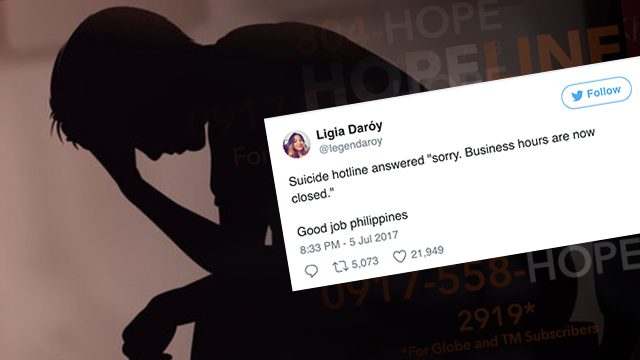SUMMARY
This is AI generated summarization, which may have errors. For context, always refer to the full article.

MANILA, Philippines – Hopeline, the national support hotline for depression and suicide prevention, is being criticized online for alleged inaccessibility.
A viral Twitter post by user Ligia Daroy claimed the hotline, which is supposed to be 24/7, reportedly stopped taking calls after “business hours.” Daroy’s tweet has been retweeted more than 5,000 times and gotten nearly 22,000 likes since it was posted last July 5.
Suicide hotline answered "sorry. Business hours are now closed."
— Ligia Daróy (@legendaroy) July 5, 2017
Good job philippines
The Department of Health (DOH) had launched the crisis support hotline in September 2016 in partnership with the Natasha Goulbourn Foundation (NGF).
Inaccessible
According to Daroy, she called the hotline around 8 pm on July 5 but got an automated voice message saying, “Sorry. Business hours are only from 6 am to 8 pm.”
“I was depressed. I thought all of my friends are tired of listening to me so I called Hopeline. Then I got, ‘Sorry. Business hours are only from 6 am to 8 pm,'” she told Rappler.
“What if it was someone who was actually ready to jump off a building, tapos ganoon ‘yung maririnig mo (then you will hear something like that)?” she added. (READ: Why we need a mental health law in PH)
Daroy said she didn’t intend for the tweet to go viral but was surprised to get responses from people with similar experiences.
I tried it too, pro ina advise na mkipagkita ako ng psychologist. Ni wala mn lng syang na advise na nkapagpagaan ng loob.
— Ash Dauntless (@DauntlessAsh8) July 6, 2017
“I didn’t mean to attack them but if it will be addressed it would be really nice,” Daroy said.
Hopeline responds
Dr Bernardino Vicente, chief of the National Center for Mental Health, denied the claims circulating on social media.
“Hindi lang naman isang number ang number ng Hopeline. We have several numbers kasi we anticipate na one thunder lang, puwedeng bumagsak ‘yung isang line. We have lines that are operated by PLDT, and lines that are operated by Globe,” he told Rappler.
(Hopeline does not have just one number. We have several numbers because we anticipate that phone lines could go down during bad weather. We have lines that are operated by PLDT, and lines that are operated by Globe.)
Mila Rolinas, Hopeline’s program consultant, said it is very likely that callers will experience a busy line when all lines are taken, especially during peak hours. There are only 12 responders handling calls. (READ: I have depression and it feels good to admit it)
She said there are also times when responders take more than 20 minutes to talk to one caller, especially during high-risk situations. But Rolinas guaranteed that Hopeline is 24/7.
In an Inquirer report, NGF said Hopeline experienced technical issues but these have since been addressed by Globe Telecom.
After that she gave the numbers of St Luke’s and East Ave’s ER.
I was alone. Inside my room. Breaking down. Can you imagine.
They’re like robots when you get to reach one plus they also seem irritated.
Vicente also denies Hopeline responders would answer in an apathetic manner. (READ: Ubial: Don’t be indifferent to people with depression)
“Definitely, hindi mag-a-answer ‘yung staff namin ng, ‘Sorry, nasa simbahan ako’ or ‘Sorry, out of line kami.’ I don’t think any of our staff ay mag-a-answer ng ganoon,” he said.
(Definitely, our staff would not answer, “Sorry, I’m at church,” or “Sorry, our lines are down.” I don’t think any of our staff would answer like that.)
Vicente said Hopeline responders are well-trained individuals whose areas of expertise are in the behavioral sciences.
Need for feedback
Vicente added that Hopeline offers those with depression a way to cope without having to disclose their identity.
“That’s the beauty of the Hopeline. You can call somebody without revealing your identity. Some clients would want to hide their identity, and Hopeline is an alternative to that,” he said. (READ: Keeping the demons at bay: Dealing with depression)
Hopeline currently does not have a formal mechanism to get feedback from callers, or those attempting to call their hotline.
But Rolinas said some callers contact them again to give updates. “‘Yung ibang callers, after going to the mental health professionals, they call para mag-feedback. They update us, saying, ‘Pumunta na po ako dito,'” she said.
(Other callers, after going to mental health professionals, they call to give us feedback. They update us, saying, “I’ve already seen a doctor.”)
Online support
Meanwhile, netizens have taken it upon themselves to form online support groups on Twitter and Facebook.
Some netizens also suggested the use of online therapy and counseling such as 7 Cups and Koko, if they really cannot contact the suicide hotline.
According to the World Health Organization (WHO), more than 800,000 people die by suicide each year, a number that translates to one death every 40 seconds.
The WHO in 2012 also ranked the Philippines 150th out of 170 countries in terms of suicide rates.
The suicide rate in the country is 2.9 in a population of 100,000 – lower than the annual global-age standardized suicide rate of 11.4.
“I really want people to start talking about it more. I hope they get the message and develop the system better,” said Daroy. – Rappler.com
Cielo Marie Esmeria is a Rappler intern.
Add a comment
How does this make you feel?
There are no comments yet. Add your comment to start the conversation.